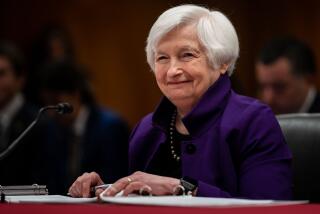Credit Crunch Goes Beyond the Crackdown on Banks : Economy: Blame the lack of business and personal saving, not the Fed or regulators, for impeding long-term growth.
- Share via
Inadequate capital for American business is a much deeper problem than the “credit crunch” that has been assigned much of the blame for the current economic downturn. The credit crunch is real and policy-makers are right to seek ways to alleviate it. But it is equally important for Washington to develop the right incentives to overcome the more serious long-term problem of low national saving.
The credit crunch refers to the reluctance of many banks to lend to apparently credit-worthy businesses. Many banks are limiting their available funds to government bonds and home mortgage loans. This shift to safer investments is in response to two recent regulatory developments: new capital requirements for banks and a new style of bank supervision.
Under new international capital standards, agreed to by the major industrial countries in 1988 but just now coming into force, banks are required to maintain minimum amounts of capital for each dollar that they invest in business loans, mortgages and government securities. This capital requirement is satisfied by the funds provided by shareholders and by uninsured bondholders.
The regulations require proportionally more capital for the presumably riskier loans to businesses than for government bonds and mortgage loans to homeowners. That’s why many banks with limited capital from shareholders and bondholders have reduced business lending in favor of government bonds and home mortgages.
Reinforcing this new cautious tendency are tougher standards by bank examiners. In the last few years, the federal agencies regulating banks have become more critical of the quality of business loans in general and commercial real-estate loans in particular. These strict new standards may be the regulators’ way of responding to accusations that lax regulation was responsible for the savings-and-loan crisis.
When bank examiners determine that a loan is in trouble, the bank must establish reserves against the possibility that the loan will eventually default. The higher level of reserves reduces current profits and available capital. Once again, the easiest way for a bank to avoid such problems is to invest in the very safe government bonds and home mortgages.
Fortunately, while some banks have indeed cut business credit in response to the higher capital requirements and the tougher supervisory standards, most banks are continuing to make commercial and industrial loans to credit-worthy customers. In addition, government officials and regulatory agencies are reviewing the banks’ methods for evaluating and maintaining reserves against troubled loans.
Despite the widespread media discussion of the credit crunch and its role in the economic downtown, the impact of Federal Reserve policy is far more important. The banking system as a whole can lend or invest only to the extent that it has deposits. And the total value of bank deposits is strongly influenced--some would say determined--by Fed policy. When the Fed pursues a restrictive policy, as it did during the second half of 1990, banks cannot expand deposits and therefore cannot make loans and investments.
If past experience is a good guide, the Fed’s tight rein on credit last year will inhibit the expansion of the economy until the middle of this year. Although the Fed has more recently begun to expand the supply of money and credit, its plan for total money growth of only about 4.5% in 1991 runs the risk of being too slow to support a vigorous recovery. It gambles that the economy can make do with less money per dollar of total spending during the recovery than in the recent past.
The relatively quick official response to the credit crunch illustrates how government policy tends to react to crises rather than to underlying fundamentals. The most serious long-term impediment to economic growth is not the credit crunch or the tightness of Federal Reserve policy. Instead it is the low level of saving in the United States.
Economic growth depends on investments--in new plant and equipment, in research and in manpower training. Bank loans are only one way to finance such investments. Business can finance them by issuing new shares of stock or by selling bonds or by retaining profits.
The common denominator to all methods of financing new investments is more saving by business and households. Government policy must pay more attention to encouraging such saving as well as to shrinking the budget deficits that absorb private saving. If the United States as a nation does not increase its saving rate, our investment and our rate of economic growth will inevitably suffer.
More to Read
Inside the business of entertainment
The Wide Shot brings you news, analysis and insights on everything from streaming wars to production — and what it all means for the future.
You may occasionally receive promotional content from the Los Angeles Times.










